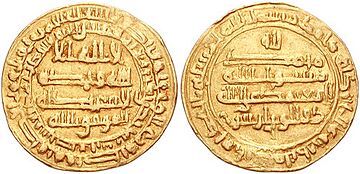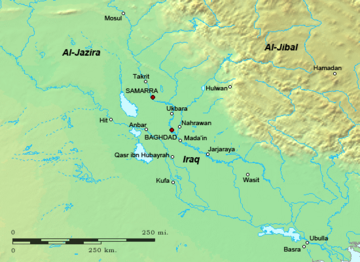Al-Muwaffaq facts for kids
Quick facts for kids Abu Ahmad Talha ibn Ja'far al-Muwaffaq bi-Allahأبو أحمد طلحة بن جعفر الموفق بالله |
|||||
|---|---|---|---|---|---|
| Regent (de facto) of the Abbasid Caliphate | |||||
| Office | June 870 – 2 June 891 | ||||
| Caliph | Al-Mu'tamid | ||||
| Born | 29 November 843 Samarra, Abbasid Caliphate |
||||
| Died | 2 June 891 Baghdad, Abbasid Caliphate |
||||
| Burial | Al-Rusafa | ||||
| Consort | Dirar | ||||
| Successor | al-Mu'tadid | ||||
|
|||||
| Dynasty | Abbasid | ||||
| Father | al-Mutawakkil | ||||
| Mother | Umm Ishaq | ||||
| Religion | Islam | ||||
| Military career | |||||
| Allegiance | Abbasid Caliphate | ||||
| Service/ |
Abbasid Army | ||||
| Years of service | 891 (end of active service) |
||||
| Rank | Commander-in-Chief | ||||
| Battles/wars | Battle of Dayr al-'Aqul, Zanj Rebellion Kharijite Rebellion |
||||
| Relations | al-Muntasir (brother) al-Musta'in (cousin) al-Mu'tazz (brother) al-Muhtadi (cousin) al-Mu'tamid (brother) |
||||
Abu Ahmad Talha ibn Ja'far (Arabic: أبو أحمد طلحة بن جعفر; born November 29, 843 – died June 2, 891), also known by his special title Al-Muwaffaq Billah (Arabic: الموفق بالله, lit. 'Blessed of God'), was an important prince and military leader of the Abbasid dynasty. He was like a prime minister or main ruler (called a de facto regent) for most of the time his brother, Caliph al-Mu'tamid, was in charge.
Al-Muwaffaq helped bring stability back to the Abbasid Caliphate after a difficult period known as the "Anarchy at Samarra". He successfully defended Iraq from the Saffarids and put down a huge slave rebellion called the Zanj Rebellion. His actions helped the Caliphate regain some of its old strength, leading to a period of recovery that continued under his son, Caliph al-Mu'tadid.
Contents
Early Life and Challenges
Talha, often called Abu Ahmad, was born on November 29, 843. His father was Caliph al-Mutawakkil (who ruled from 847 to 861), and his mother was a Greek slave named Umm Ishaq.
In 861, Abu Ahmad was in Samarra when his father was killed by the Turkish military slaves, known as ghilman. This event started a difficult time called the "Anarchy at Samarra". During this period, different Turkish military leaders fought for control of the government and its money.
The Siege of Baghdad
In February 865, Caliph al-Musta'in (who ruled from 862 to 866) and some Turkish officers left Samarra for Baghdad. They had the support of Baghdad's governor, Muhammad ibn Abdallah ibn Tahir. The Turkish army in Samarra then chose Abu Ahmad's brother, al-Mu'tazz (who ruled from 866 to 869), to be the new Caliph. Abu Ahmad was put in charge of the fight against al-Musta'in.
The siege of Baghdad lasted from February to December 865. Eventually, Abu Ahmad and Muhammad ibn Abdallah made a deal for al-Musta'in to step down. After this, al-Mu'tazz became Caliph in Baghdad. During this time, Abu Ahmad became very close with the Turkish military leaders, especially Musa ibn Bugha.
Imprisonment and Release
When Abu Ahmad returned to Samarra, the new Caliph al-Mu'tazz at first welcomed him. However, six months later, Abu Ahmad was put in prison because he was seen as a possible rival. Another of his brothers was also imprisoned and sadly executed. But Abu Ahmad was protected by the Turkish military and survived.
He was later released and sent away to Basra. Eventually, he was allowed to return to Baghdad. He became very popular there. When al-Mu'tazz died in July 869, many people wanted Abu Ahmad to become Caliph instead of al-Muhtadi (who ruled from 869 to 870). However, Abu Ahmad refused and promised his loyalty to al-Muhtadi.
Becoming Regent of the Caliphate

When al-Muhtadi was killed by the Turks in June 870, Abu Ahmad was in Mecca. He quickly went to Samarra. There, he and Musa ibn Bugha effectively took control of the government, leaving the new Caliph, al-Mu'tamid (who ruled from 870 to 892), with less power.
Al-Muwaffaq was different from most Abbasid princes because he worked closely with the Turkish military and was very active in military matters. This was similar to his grandfather, Caliph al-Mu'tasim (who ruled from 833 to 842). This strong connection with the Turkish army became the base of al-Muwaffaq's power. He made sure the Turkish soldiers were paid and respected, and in return, they were loyal to him.
After the city of Basra was attacked by the Zanj rebels in 871, Abu Ahmad was given control over many important areas. These included the Hejaz, Yemen, Iraq (with Baghdad and Wasit), Basra, Ahwaz, and Fars. To show his authority, he took the special title al-Muwaffaq Billah, meaning 'Blessed of God'.
His power grew even more on July 20, 875. The Caliph included him in the line of succession after his own young son, al-Mufawwad. This meant al-Muwaffaq was given charge of the eastern parts of the empire, while al-Mufawwad got the western parts. In reality, al-Muwaffaq continued to control the western areas too.
With Caliph al-Mu'tamid mostly staying in Samarra, al-Muwaffaq and his personal assistants (secretaries) effectively ruled the Caliphate from Baghdad. Al-Muwaffaq even gained the right to choose the Caliph's main advisors, called viziers, after the old vizier died in 877.
Important Military Campaigns
As the main military leader, it was up to al-Muwaffaq to deal with many challenges to the Caliphate's power. Historian Michael Bonner said that "al-Muwaffaq's decisive leadership was to save the Abbasid caliphate from destruction on more than one occasion." The biggest threats were the Zanj Rebellion in southern Iraq and the growing power of the Saffarid dynasty in the east. Al-Muwaffaq's strong leadership was key to stopping them.
Facing the Saffarids
Ya'qub ibn al-Layth, a humble soldier nicknamed al-Saffar ('the Coppersmith'), had taken advantage of the "Anarchy at Samarra" to build his own power. By 873, he controlled most of the eastern lands of the Caliphate. In 875, he took control of Fars, a province that provided a lot of money for the Caliphate. This was also dangerously close to Iraq.
The Abbasids tried to stop Ya'qub by officially recognizing him as governor of the eastern provinces. They even gave him special honors, like adding his name to the khutba (Friday sermon) and making him chief of police in Baghdad. However, in 876, Ya'qub marched towards Baghdad. Al-Muwaffaq and Musa ibn Bugha led the Abbasid forces and defeated him at the Battle of Dayr al-Aqul near Baghdad. This victory, which surprised many, saved the capital city.
Even after this defeat, the Saffarids still controlled most of the Iranian provinces. In 879, the Abbasid court had to recognize Ya'qub as governor of Fars. When Ya'qub died later that year, his brother Amr ibn al-Layth took over. Amr agreed to recognize the Caliph's rule and pay a yearly tribute.
After the Zanj rebellion was mostly put down, al-Muwaffaq focused on the east again after 883. He tried to take back Fars and Khurasan from Amr. There were several battles, and Amr was defeated by al-Muwaffaq in person in 887. However, Amr managed to retreat. Later, al-Muwaffaq had to make a deal in 888/9, which mostly restored Amr's power in the eastern provinces in exchange for tribute.
Stopping the Zanj Revolt
The fight against the Zanj Rebellion was a very long and difficult conflict. This uprising of enslaved people in the marshlands of southern Iraq began in September 869. It almost destroyed the Caliphate. Because of the Saffarid threat, the Abbasids couldn't fully focus on the Zanj until 879.
At first, the Zanj rebels were winning. They captured much of southern Iraq, including Basra and Wasit. The Abbasid armies struggled to stop them. But things changed after 879 when al-Muwaffaq's son, Abu'l-Abbas (who would later become Caliph al-Mu'tadid), took command. Al-Muwaffaq himself joined the fight in 880.
Through a series of battles in the marshes, the Abbasid forces pushed the Zanj back to their capital, Mukhtara. Mukhtara fell in August 883. This victory over the Zanj was a huge success for al-Muwaffaq and his government. Al-Muwaffaq received a special victory title: al-Nasir li-Din Allah, meaning 'he who upholds the Faith of God'.
Dealing with the Tulunids
At the same time, al-Muwaffaq also faced a challenge from Ahmad ibn Tulun, the ambitious governor of Egypt. Ibn Tulun, the son of a Turkish slave, had been Egypt's governor since the time of Caliph al-Mu'tazz. He gained more power in 871 by taking direct control of Egypt's money and using it to build his own army. Al-Muwaffaq was busy with the Saffarids and Zanj rebels, so he couldn't react right away. This allowed Ibn Tulun to become very strong in Egypt.
Open conflict between Ibn Tulun and al-Muwaffaq began in 875/6. Ibn Tulun sent more tax money to Caliph al-Mu'tamid than to al-Muwaffaq. This angered al-Muwaffaq, who felt he deserved the larger share for his fight against the Zanj. Al-Muwaffaq tried to replace Ibn Tulun, but couldn't. He sent an army to Syria, but it failed to achieve anything. In 878, Ibn Tulun publicly showed his support for al-Mu'tamid and opposition to al-Muwaffaq by taking the title 'Servant of the Commander of the Faithful' (mawla amir al-mu'minin).
Ibn Tulun then took control of Syria and the border areas with the Byzantine Empire. However, his son tried to take his place in Egypt, possibly encouraged by al-Muwaffaq. This failed, and Ibn Tulun imprisoned his son. After returning from Syria, Ibn Tulun put his own name on coins, along with the Caliph's, showing he was acting as an independent ruler.
In 882, a general of Ibn Tulun defected to the Abbasids. This, along with Caliph al-Mu'tamid trying to escape to Ibn Tulun, caused more problems. Al-Muwaffaq had the Caliph arrested and put him under house arrest. Al-Muwaffaq then named someone else as governor of Egypt and Syria, though this was mostly symbolic. Ibn Tulun, in turn, gathered religious scholars who declared al-Muwaffaq a usurper (someone who takes power illegally) and called for a holy war (jihad) against him. Both sides publicly criticized each other, but there wasn't much direct fighting.
After Ibn Tulun died in 884, al-Muwaffaq tried again to take back Egypt from Ibn Tulun's son, Khumarawayh. But Khumarawayh defeated an Abbasid army and expanded his control. In 886, al-Muwaffaq was forced to recognize the Tulunids as hereditary governors of Egypt and Syria for 30 years, in exchange for a yearly payment.
Final Years and Succession
Towards the end of the 880s, al-Muwaffaq's relationship with his son Abu'l-Abbas became difficult, though the exact reason is not clear. In 889, Abu'l-Abbas was arrested and imprisoned by his father's orders. He remained in prison until May 891.
By this time, al-Muwaffaq was very ill with gout, a painful joint condition. He could no longer ride a horse and needed a special chair to be carried. It was clear he was close to death. Despite opposition from some officials, Abu'l-Abbas was released from prison because he was very popular with the soldiers and the people. He was then recognized as his father's heir.
Al-Muwaffaq died on June 2, 891, and was buried in al-Rusafah. Two days later, Abu'l-Abbas took over his father's duties and received promises of loyalty as the next in line after al-Mufawwad. In October 892, Caliph al-Mu'tamid died. Abu'l-Abbas then became Caliph, taking the name al-Mu'tadid. He quickly became known as a very powerful and effective Caliph, continuing the recovery that his father al-Muwaffaq had started.
|
See Also



